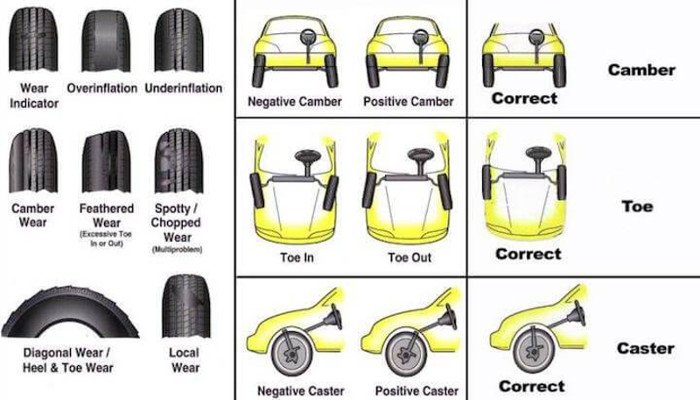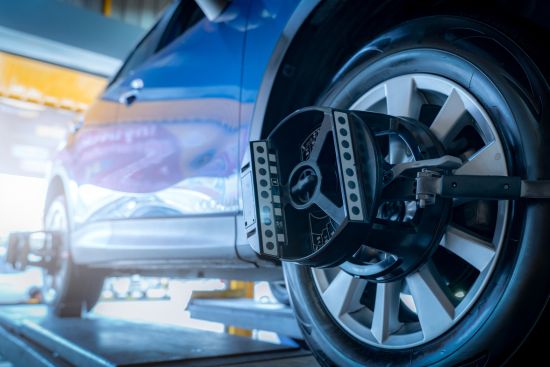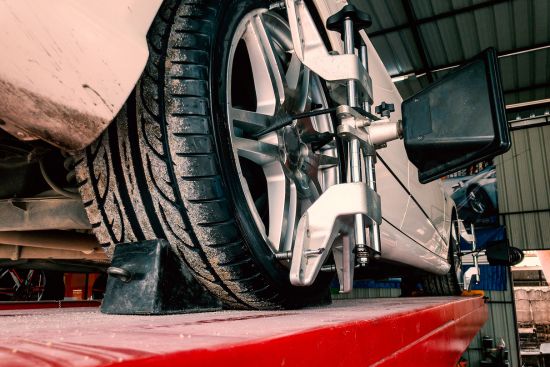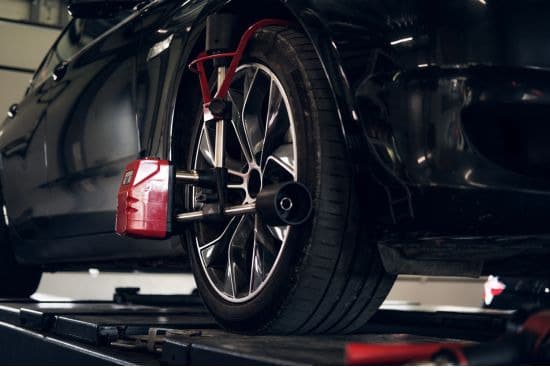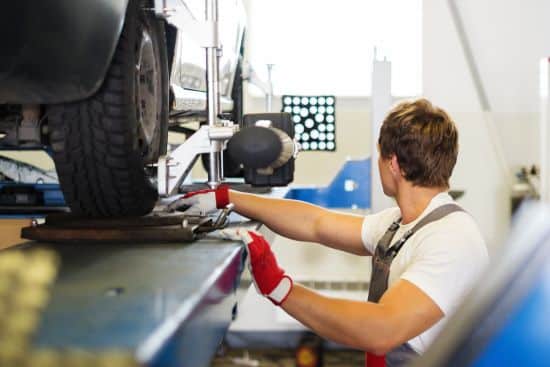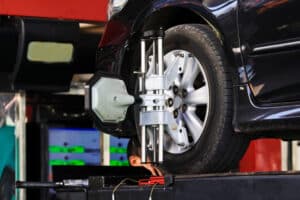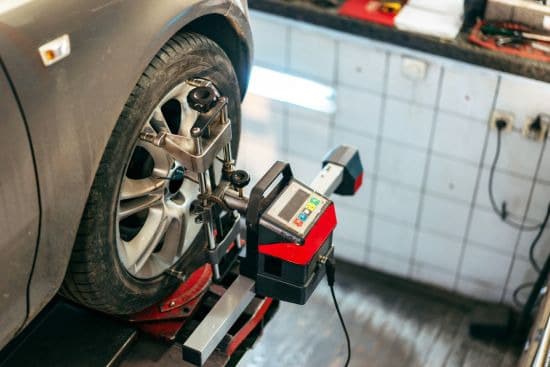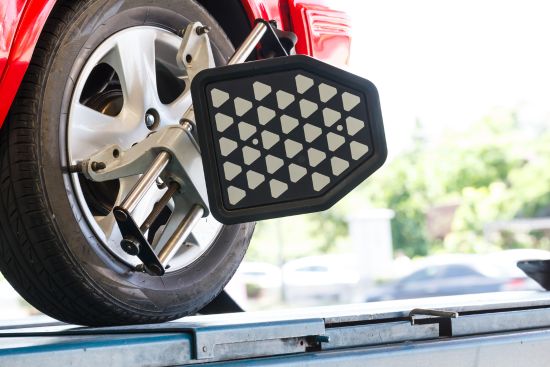A tire alignment is actually an adjustment to your suspension and not your tires. It is an important service because it helps you get the best gas mileage, improves traction, and makes for a more comfortable drive. Below I will discuss where to get an alignment, how to know if you need one, the cost, and the frequency you should have it done. I’ll also share my experience with the shop that does tire alignment near me.
Map of Tire Alignment Near Me
For “Tire Alignment Near Me”, see the map below for locations…
What Exactly is Tire Alignment?
Though it’s sometimes called a “tire” alignment, an alignment isn’t actually fixing a problem with your tires or wheels. An alignment is a repair to your car’s suspension system, or the part of the car that attaches the body to the wheels. It’s called a tire standard wheel alignment because part of the procedure involves adjusting the angle that the tires sit on the body of the car. This angle, in turn, changes the way they make contact with the road.
There are three things to think about when your car needs an alignment – camber, caster, and toe. Camber refers to the angle of the front tires when you are facing the front of the car. If they are tilted too far out or in, they need an alignment. Toe also refers to the angle of the front tires, but looking down at them from above. The same rules apply – if they are tilted too far out or in, you need to get an alignment. Caster does not refer to the tires, but to the steering axis in the center of your wheels.
When looking at the car from the side, if the steering axis is tilted too far to the left or right, your car needs an alignment.
Causes of Uneven Tire Wear Due to Poor Alignment
Since this is a used tire blog, we often closely inspect the type of tread wear on used tires. You can often tell when a tire was the victim of poor alignment. If you are buying used its helpful to understand some tire basics and how to evaluate the tread wear properly for safety.
The Process of Tire Alignment
Pre-Alignment Check
Before diving into the wheel alignment process, it’s crucial to understand the pre-alignment check’s significance. A pre-alignment check involves inspecting various aspects of your vehicle to ensure it is in a condition to undergo an alignment.
This includes checking the tire balance, ensuring there is no vibrating steering wheel, and confirming that the vehicle is not pulling to one direction. The vehicle’s steering and suspension systems will also be evaluated to ensure there are no worn-out components that might affect the alignment outcome.
In some cases, a free alignment check might be offered by alignment services to give you a preliminary understanding of your vehicle’s alignment status. This step is vital to identify any alignment problem that might be causing issues like a vehicle pulling to one side or a vibrating steering wheel while driving.
Alignment Techniques and Methods
Wheel alignment service providers utilize various techniques and methods to ensure your vehicle’s wheels are aligned according to the manufacturer’s specifications. The primary goal is to adjust the wheels’ angles so that they are perpendicular to the ground and parallel to each other, ensuring optimal tire wear and a straight and true drive.
There are generally three main aspects of wheel alignment that technicians focus on, often referred to as the three primary angles of alignment: camber, toe, and caster.
- Camber is the inward or outward angle of the wheel when viewed from the front of the vehicle. Improper camber can lead to tire wear and can cause the vehicle to pull to one side.
- Toe alignment is concerned with the extent to which your wheels turn inward or outward when viewed from above. Incorrect toe alignment can lead to “feathering” along the tire tread.
- Caster is the angle of your wheel’s pivot, which is attached to the suspension, and when this angle is out of alignment, straight-line tracking is affected.
In some instances, lifetime wheel alignment packages might be available, which can be a cost-effective option for those who plan to keep their vehicle for several years. It’s essential to choose a reliable wheel alignment service that ensures safety and adheres to your vehicle manufacturer’s specifications.
Post-Alignment Check
After the alignment services have been performed, a post-alignment check is crucial to verify that the wheels are aligned to the manufacturer’s specifications and that the vehicle is not exhibiting signs of misalignment like pulling or vibrating steering wheel.
A wheel alignment check involves utilizing specialized equipment to measure the wheels’ angles and compare them to the vehicle manufacturer’s detailed specifications, ensuring that the wheels are aligned correctly.
In some cases, alignment services might recommend scheduling a follow-up check after driving the vehicle for a specified number of miles to ensure that everything remains properly aligned. This is particularly relevant if the vehicle had a significant alignment problem or if it was pulling to one side prior to the alignment.
Ensuring proper alignment post-service is crucial for maintaining optimal vehicle performance, safety, and longevity of your tires. Always prioritize safety and ensure that the alignment is checked regularly to avoid any potential issues down the line.
When Should I Align My Tires?
A wheel alignment is a repair, not something that is part of a regular maintenance routine. There are a few major indicators that your car may need an alignment.
The first is uneven tire wear. If one or two of your tires are significantly more worn than the others, it can cause problems with steering. This affects your ability to control the car. If you notice signs of uneven tire wear when driving or by visual cues, you may want to see if you need an alignment.
Another sign is pulling in the steering wheel. Ideally, if you were to take your hands off of the steering wheel while driving (which, of course, you would never do) the car would continue to drive in a relatively straight line. If the car feels like it’s going to veer off the left or right if you relax your grip on the wheel, this can be a big indicator that your car needs a tire alignment. Similarly, if you need to hold the steering wheel at an angle while driving straight, you need of an alignment.
Recognizing When Your Vehicle Needs Alignment
Proper alignment of your vehicle’s wheels is crucial for ensuring a smooth and safe drive. But how do you know when it’s time to get your wheels aligned? Here are some simple pointers to help you identify the need:
- Signs and Symptoms:
- Uneven Tire Wear: One of the most noticeable signs is when your tires wear out unevenly. This could mean that some tires are bearing more weight than they should.
- Vehicle Pulling to One Side: If your car tends to drift to the left or right while you’re driving on a straight road, it’s a clear indication that you need your wheels aligned.
- Steering Wheel Vibration: A vibrating steering wheel can be a result of misaligned tires.
- Off-Center Steering Wheel: If your steering wheel isn’t centered when driving straight, it’s time to consider alignment.
- Squealing Tires: Loud noises, especially squealing from the tires, can be a symptom of misalignment.
- Potential Causes of Misalignment:
- Potholes and Rough Roads: Driving frequently on roads with potholes or over rough terrains can lead to misalignment.
- Accidents: Even minor fender benders can cause alignment issues.
- Worn Out Suspension: The suspension system plays a key role in keeping your car aligned. Worn out parts can lead to misalignment.
- Improper Previous Alignment: If the last alignment wasn’t done correctly, you might need an alignment sooner.
- Risks of Ignoring Misalignment:
- Safety Concerns: Misalignment can compromise the safety system alignment of your vehicle, making it more prone to accidents.
- Increased Fuel Consumption: A misaligned vehicle has to work harder, leading to higher fuel consumption.
- Costly Repairs: Ignoring the need for alignment can lead to other damages, increasing your repair bills.
- Reduced Tire Lifespan: Misaligned wheels can cause your tires to wear out faster, leading to frequent replacements.
Remember, regular check-ups and paying attention to these signs can save you from potential risks. If you notice any of these symptoms, make an appointment today with service providers like Pep Boys to ensure your vehicle’s optimal performance.
What are the Benefits of Aligning Wheels?
An alignment is a repair, meant to fix some part of the suspension system that has become dysfunctional. Making sure your tires are properly aligned is crucial for safe driving. A faulty suspension system can lead to steering trouble.
Mis-aligned tires can cause the car to veer sharply to the right or left, dramatically decrease the lifespan of your tires, and make it difficult to control the car. A mis-aligned caster, especially, can cause problems with steering, turning, and stability.
Mis-alignments are typically caused by natural wear and tear, especially in old cars. “Natural wear-and-tear,” however, can indicate worn parts in the car’s suspension system, especially worn bearings and ball joints. These little parts hold the suspension system together. If they are falling apart, they must be replaced if you want to continue driving safely.
An alignment can not only save your tires and make your car safer to drive, it can also save your suspension system by revealing deeper internal problems. The suspension system connects the body of the car to the wheels. A faulty suspension system can most certainly make a car dangerous and difficult to drive.
Where Can I Get a Tire Alignment Near Me?
A wheel alignment can be a big job and one that is not normally recommended to be done at home. You can request that your alignment be checked as part of your annual inspection. This will catch alignment problems before they turn into bigger suspension problems. It is absolutely recommended that you check the alignment after getting a new set of tires (or used). Often tire manufacturers will offer alignment checks for free with the purchase of new tires.
Most garages and body shops will do regular wheel alignments, or will at least do an alignment check to see if one is necessary. Car dealerships typically don’t do alignments, as they aren’t necessary. A new car should have perfect alignment when you drive it out of the dealership. Though it can be a big job, alignments aren’t necessarily uncommon. So this is a standard service typically offered by the auto service departments at big box retailers like Walmart, Costco, and Sears. A wheel alignment can be a big job for a small gas station garage. An auto repair shop or tire shop are typically your best bets for quality alignments. They will often do it with computerized equipment.
How much Does a Wheel Alignment Near Me Cost?
If only two wheels are off, you shouldn’t pay more than $75 for a tire alignment. Double that, of course, if all four tires are off. However, many shops recommend doing a tire rotation at the same time to counteract any uneven tire wear caused by the mis-alignment. Since it is a relatively common repair, some shops offer alignment warranties for as much as $200. If you drive a lot, especially on harsh or unpaved roads, this may be a worthwhile investment, as wear-and-tear is the number one culprit for mis-aligned tires.
Alignments can start to become more pricey when it’s not the tires that are in trouble, but the front axle. The front axle is critical for steering, and so if the axle is damaged it absolutely must be replaced, and the wheels subsequently re-aligned. However, replacing a front axle can cost as much as $150 for the part, and double that for labor. Regularly rotating your tires and doing annual wheel alignment services and checks can help you to spot axle problems before the steering system degenerates to the point of replacement.
What’s the Difference Between Balancing and Tire Alignment?
Balancing is often recommended to be done at the same time as an alignment, but they are technically two different procedures. A tire alignment is a repair that targets problems in the car’s suspension system. An alignment typically takes the form of adjusting the angle of the tires so that the front and back tires are perfectly lined up. Balancing, on the other hand, has to do with weight distribution across the wheels and tires. An improper alignment can cause your tires to become unbalanced, which will make the car drivable but will ultimately cause uneven tire wear and shorten the lifespan of your tires.
Balancing should be a regular part of a tire alignment. Make sure that your tires will be balanced as well as aligned. Even if your alignment is ultimately a problem with the front axle, rather than the tires, the tires should still be balanced after the axle is replaced. Again, the process of replacing the axle can cause your tires to become unbalanced. It can ultimately lead to yet another tire alignment in the future.
What’s the Difference Between Rotation and Alignment?
An alignment is a repair, intended to fix a problem in the car’s suspension system. When you drive your brand new car out of the dealership parking lot, the alignment is pristine. A rotation, on the other hand, is a standard maintenance procedure, on the same routine level as an oil change.
A tire rotation means changing the position of the tires to ensure even tire wear. Going too long without a tire rotation can severely clip the lives of your tires. Routine tire rotations can also be preventative in terms of tire alignments, as the tires should be perfectly aligned when they are re-fitted to the body of the car. Wheel alignments are often made necessary because of uneven tire wear, and so regular rotations will not only increase the lifespan of your tires but can help to preserve their proper alignment over time.
It’s often recommended to do a tire rotation and an alignment at the same time. Mis-alignment in the tires can sometimes cause problematic tire wear patterns. Rotating the tires with proper wheel alignment can go a long way toward correcting any uneven tire wear that was caused by the mis-alignment.
Whats The Difference Between a Front End Alignment and a Wheel Alignment?
There are different types of alignments that can be performed. For the vehicle to operate correctly all four wheels must be in perfect alignment. This allows the vehicle to travel straight and turn with all four tires in sync. Any variation from perfect alignment impacts the suspension and can cause your tires to wear down more quickly.
2 Wheel Alignment
This alignment is also called a front wheel alignment. The adjustment only occurs on the front suspension. The caster, camber, and toe or tuned so that your rear wheels are parallel to the center. This type of adjustment is done mostly on older vehicles.
Thrust Alignment
This alignment is done if your vehicle is not equipped with an adjustable rear suspension system. Here just the front wheels are adjusted to where the two rear wheels are pointed (thats called the thrust line).
4 Wheel Alignment
This alignment is performed on a vehicle equipped with a 4 wheel independent suspension system. Here a mechanic adjusts the suspension on all 4 wheels and can vary from the front to the back. On the front end the adjustment occurs on the toe, caster, and camber. On the back the adjustment only occurs on the toe and camber. All 4 wheels are adjusted in relation to the vehicle center.
Importance of Regular Tire Alignment
- Safety Concerns
Ensuring that your vehicle undergoes regular wheel alignment services is pivotal in maintaining the safety of your vehicle on the road. Misaligned tires can lead to uneven tire wear, impacting the vehicle’s stability and, consequently, the safety of the driver, passengers, and other vehicles on the road.
A car that pulls to one side could be difficult to control, especially in adverse weather conditions, and might increase the risk of accidents.
- Extending Tire Life
Proper alignment is crucial in prolonging the life of your tires. When tires are not aligned, they wear unevenly and prematurely, necessitating replacements sooner than if they were maintained in alignment.
The minimum monthly payments on new tires can be an unwelcome expense, and thus, ensuring that your tires last as long as possible by investing in regular alignments can be a cost-effective strategy in the long run.
- Ensuring Optimal Vehicle Performance
A vehicle with well-aligned tires performs optimally in various aspects, including steering, fuel efficiency, and overall handling. Misalignment can lead to issues like improper steering and uneven driving, which can be particularly noticeable when driving at higher speeds.
Moreover, if you’re utilizing services like Pep Boys for your alignment, you might notice that your vehicle runs smoother and offers a more comfortable ride post-service. This is because proper alignment ensures that your vehicle doesn’t have to work as hard, thereby ensuring optimal performance.
- Fuel Efficiency
Misaligned tires can cause your vehicle to work harder, as the misalignment creates resistance, making the engine exert more effort and, consequently, consume more fuel. By ensuring that your tires are properly aligned, you enhance the vehicle’s fuel efficiency. This not only saves you money on fuel but also contributes to reducing the vehicle’s carbon footprint.
In the context of staying informed and ensuring that your vehicle gets timely wheel alignment services, consider subscribing to updates and reminders from your preferred service provider. For instance, if you’ve utilized Pep Boys for services, you might opt to receive notifications on upcoming deals. Reminders for your next alignment, and other pertinent information directly to your mobile device.
However, be mindful of message and data rates that may apply when receiving such notifications. Always ensure to provide your mobile number with the understanding of the data rates and the option to text stop to discontinue the messages at any point.
In summary, regular tire alignment is not merely a suggestion but a necessity for ensuring safety, extending tire life, optimizing vehicle performance, and enhancing fuel efficiency. Whether you choose Pep Boys or another provider for your wheel alignment services, maintaining a schedule for this crucial service is imperative in safeguarding your vehicle’s functionality and your safety on the road.
Tire Alignment Near Me Conclusion
Tire alignments are a very common repair. They are recommended by some dealerships to be done every 10,000 miles for optimum performance. That being said, keeping up with routine tire maintenance services like rotations and tire balancing, can often prevent the need for an alignment, sometimes for years. While the repair is typically called a “tire alignment,” it’s actually a repair that makes adjustments to the car’s suspension system. That’s the part of the car that connects the body to the wheels. Since the suspension system directly affects steering, turning, and driving stability, mis-aligned tires cannot be ignored for long.
An annual alignment check can prevent the need for more intensive alignments, like replacing the car’s front axle. This can not only save your tires and prolong the life of your car, but it can save you a big repair bill also. While a basic alignment will typically cost around $75, replacing the front axle can easily cost you twice as much. Finally, though tire alignment, balancing, and rotation are technically three separate procedures, it’s recommended to do all three together. Failure to do one of these repairs can often necessitate the other two. That’s what I have learned from the shop that does tire alignment near me.
Frequently Asked Questions
How Much Does a Tire Alignment Near Me Cost?
Based on current US trend reports a front end alignment (two wheel alignment) costs $50-$75. A four wheel alignment will cost $100 to $150. You can often find discounts and coupons for alignment service to reduce costs.
What Does Aligning Your Tires Do?
Alignment is the process of setting your tires to sit on the road at the proper angle. It is actually an adjustment to your suspension and not your tires. It resets your wheels to recommended specifications for the best fuel economy, traction, ride comfort, and optimal tire life.
How Do You Know When You Need an Alignment?
5 common indicators that an alignment is needed:
- The car is pulling to one side of the road.
- The tire treads are wearing unevenly.
- The steering wheel moves off center while you drive.
- The steering wheel vibrates when you accelerate.
- The tires are squeaking, knocking or rubbing when you take corners
How Often Should You Get an Alignment?
Mechanics recommend you get an alignment every two to three years. It should also be completed when you purchase new tires or you identify issues such as uneven tread wear or your vehicle is pulling to one side of the road.
Is it Bad to Drive With a Bad Alignment?
Driving a vehicle with improper alignment causes uneven tire wear. This can result in reduced life span of the tire, increased fuel consumption, and reduced traction.
